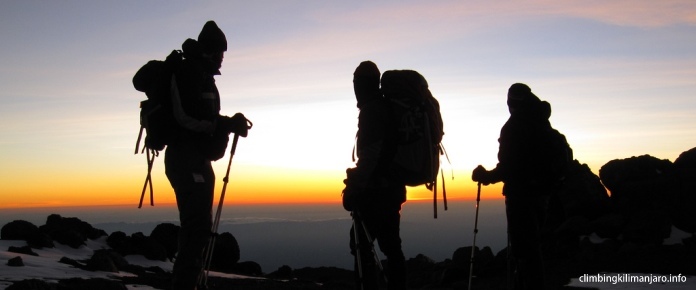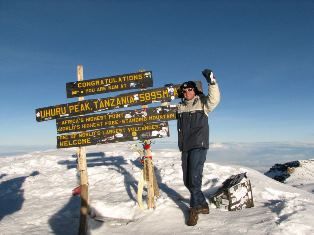Safety
Kilimanjaro is potentially hazardous.
Trekking at high altitude is dangerous due to the thin air. Unless you have previous experience of trekking or climbing at altitude, it is very difficult to know how you are going to react to altitude, or how well you will acclimatize.

The main concern when climbing Kilimanjaro is altitude sickness.
This condition is an acid-alkali imbalance in the blood and body fluids which affects climbers indiscriminately. Whatever your level of fitness, it may not reduce your chances of getting some degree of altitude sickness because almost everyone does. Surprisingly, young, physically fit males are more likely to suffer from altitude illnesses than any other demographic group! This is largely due to their physical ability to ascend quicker than many other individuals.
High altitude is defined in the following three categories:
- High Altitude: 5,000 ft – 11,500 ft
- Very High Altitude: 11,500 ft – 18,000ft
- Extreme Altitude 18,000 ft+ (Kilimanjaro summit 19,340 ft)

Some people may experience symptoms of altitude sickness from as low as 8,000 feet; however more serious effects would not usually arise until around 12,000 feet. The main consideration is not how high you are going, but how quickly you are gaining altitude.
Altitude sickness and Acute Mountain Sickness, known as AMS, are caused by the reduction in oxygen levels at altitudes above 10,000 feet. You should allow your body time to acclimatize and cope with the lack of oxygen. The best way to do this is by choosing to climb Kilimanjaro using a route that lasts for 7 or more days.
There is medication that you can take that will help with the symptoms of altitude sickness. However the only cure is to descend from altitude as quickly as possible. You should never underestimate the dangers of Acute Mountain Sickness and must always follow the instructions of your guide.
Acute Mountain Sickness (AMS)
Acute Mountain Sickness or altitude sickness is very common at high altitude. At over 10,000 feet (3,000 m) approximately 75% of people will suffer mild symptoms of altitude sickness.
Altitude sickness is classified as Mild, Moderate and Severe, with High Altitude Pulmonary Oedema and High Altitude Cerebral Oedema being two conditions associated with Severe Acute Mountain Sickness.
Mild Acute Mountain Sickness symptoms include:
- Headache
- Nausea & Dizziness
- Loss of appetite
- Fatigue
- Shortness of breath
- Disturbed sleep
- General feeling of malaise
Symptoms do not usually prevent normally activity but tend to be worse at night. The symptoms usually disappear within two to four days, ascent can continue at a moderate rate as long as the symptoms remain mild.
Moderate Acute Mountain Sickness symptoms include:
- Severe headache that is not relieved by medication
- Nausea and vomiting, increasing weakness and fatigue
- Shortness of breath
- Decreased co-ordination
Symptoms usually make normal activity, such as walking, difficult. The best test for moderate acute mountain sickness is to get the person to walk in a straight-line heel to toe. If a person is unable to walk a straight line it is a clear indication that immediate descent is required.
Severe Acute Mountain Sickness symptoms are an increase in the severity of:
- Shortness of breath at rest
- Inability to walk
- Decreasing mental status
- Fluid build-up in the lungs
- Severe Acute Mountain Sickness requires immediate descent to a lower altitude.
High Altitude Pulmonary Edema (HAPE) symptoms include:
- Shortness of breath (at rest)
- Tightness in the chest, and a persistent cough bringing up white, watery, or frothy fluid
- Marked fatigue and weakness
- A feeling of impending suffocation at night
- Confusion and irrational behavior
High Altitude Pulmonary Edema results from a lack of oxygen resulting in a buildup of fluid in the lungs. This fluid prevents effective oxygen exchange and as the condition worsens the level of oxygen in the bloodstream decreases, which leads to impaired cerebral function. The accumulation of fluid in the lungs can come on quickly and kill a victim within a few hours.
Anyone suffering from HAPE must be evacuated to a medical facility for treatment. It is crucial to get the victim to a lower elevation as soon as possible, even if that means carrying the person. Oxygen is often used to treat HAPE on mountaineering expeditions (in conjunction with a hyperbaric bag if available), but the best treatment is a fast and immediate descent. The victim should be kept warm or the pressure in their pulmonary vessels may increase even further, and you don’t want that.
High Altitude Cerebral Edema (HACE) symptoms include:
- Headache
- Weakness
- Disorientation
- Loss of co-ordination
- Decreasing levels of consciousness
- Loss of memory
- Hallucinations & Psychotic behavior
- Coma
The most serious altitude-related illness is called High Altitude Cerebral Edema (HACE). The large and small arteries of the brain dilate so they can carry more blood and more oxygen, causing the brain to swell.
One of the obvious results of this swelling is a tremendous headache. Other symptoms are confusion, hallucination, an inability to control emotions, and a staggering walk. The staggering walk is often one of the most definitive ways of identifying a HACE victim. If a person cannot walk heel to toe along a straight line they are in trouble and need to descend.
High Altitude Cerebral Edema usually occurs after a week or more at high altitude. Severe cases can lead to death if not treated quickly. Anyone suffering from symptoms must be evacuated to a medical facility for treatment. It is imperative to get the victim to a lower elevation as fast as possible.
There are no hard and fast rules about who will be affected by these illnesses. Some Himalayan experts who have been climbing for years can experience altitude sickness. Meanwhile, inexperienced climbers going high for the first time might feel fine all the way to the top of Kilimanjaro.
Those intending to climb Kilimanjaro should seek the advice of their doctor.

Various medical conditions may complicate matters on Kilimanjaro, especially any issues related to the heart or lungs. Additionally, certain medications may place climbers at a greater risk on the mountain. For your safety you should definitely not be climbing at altitude against your doctor’s advice. Make sure you are medically cleared for the trip.
You should not climb at altitude if you have sickle cell disease, recurrent pneumothorax (burst lung), pregnant (above 3,500m), a respiratory problem, sore throat, cold, cough, increased temperature or a nose bleed. People who have had laser surgery for short sight may experience vision changes (over 4,500m).
What can I do to prevent altitude sickness?
Most of the steps to aid your acclimatization and reduce the symptoms of altitude sickness will be taken by your guides, but it may be useful for you to know some preventative measures along with a few of the signs and symptoms.
- On arrival in Moshi, do not overexert yourself, or move higher for the first 24 hours after arriving. We recommend that you take it easy, perhaps by relaxing by the pool.
- Avoid tobacco, alcohol and other depressant drugs including, barbiturates, tranquilizers, sleeping pills and opiates such as dihydrocodeine. These cause a worsening of symptoms.
- Stay properly hydrated; acclimatization is often accompanied by fluid loss, so you need to drink lots of fluids to remain properly hydrated (at least four to six liters per day). Urine output should be copious and clear to pale yellow.
- Eat a high calorie diet while at altitude.
- Take it easy and don’t overexert yourself. I cannot emphasize strongly enough the words of the guides “pole, pole” meaning slowly, slowly. It really will increase your chances of getting to summit. Walk slow!
- Climb high and sleep low; when possible, sleep at an altitude lower than the highest point you have walked to. This is determined by the route you choose.
- Remember that all people acclimatize at different rates. Do not worry if you appear to be the only person in your group suffering, it may just be that it has affected you sooner than other members of your group.
- If you begin to show symptoms of altitude sickness, let your guide know. He or she may have some tips for you. Always take the advice of your guide as your health and safety is the most important thing to them. If symptoms get bad, go down!
Altitude sickness medication (Diamox)
Acetazolamide (diamox) is used for the treatment and prevention of altitude sickness; diamox does not mask the symptoms altitude sickness but actually helps to treat the problem. Side effects of taking diamox include; tingling of fingers, toes and face. Carbonated drinks tasting flat. Increased urination and occasionally blurred vision. It would be advisable to take a trial course prior to going to Kilimanjaro as any severe allergic reactions are easier to treat here than at a remote location.

Nutritional Altitude Supplement (ALTI-VIT)
ALTI-VIT is a unique vitamin formula which has been developed to support your bodies requirements at altitude. Its ingredients include: Siberian Ginseng, Vitamin C, Reishi Mushroom Extract and Ginkgo Biloba, ALTI-VIT is a nutritional altitude supplement to assist with: oxygen uptake, energy production, immune function and sleep quality. ALTI-VIT contains 100% natural ingredients and is available without prescription. More information on the benefits and effects can be found on the ALTI-VIT website.
Analgesics (pain killers)
Ibuprofen/Nurofen is effective at relieving altitude induced headaches.
Don’t be a victim of summit fever.
“Summit fever” is a mountaineering term used to describe the compulsion to reach the summit of a mountain at all costs. Denial is a huge issue on big mountains. People can become over-adamant about reaching the summit and take stupid risks with their health. Be smart and know when to turn around.